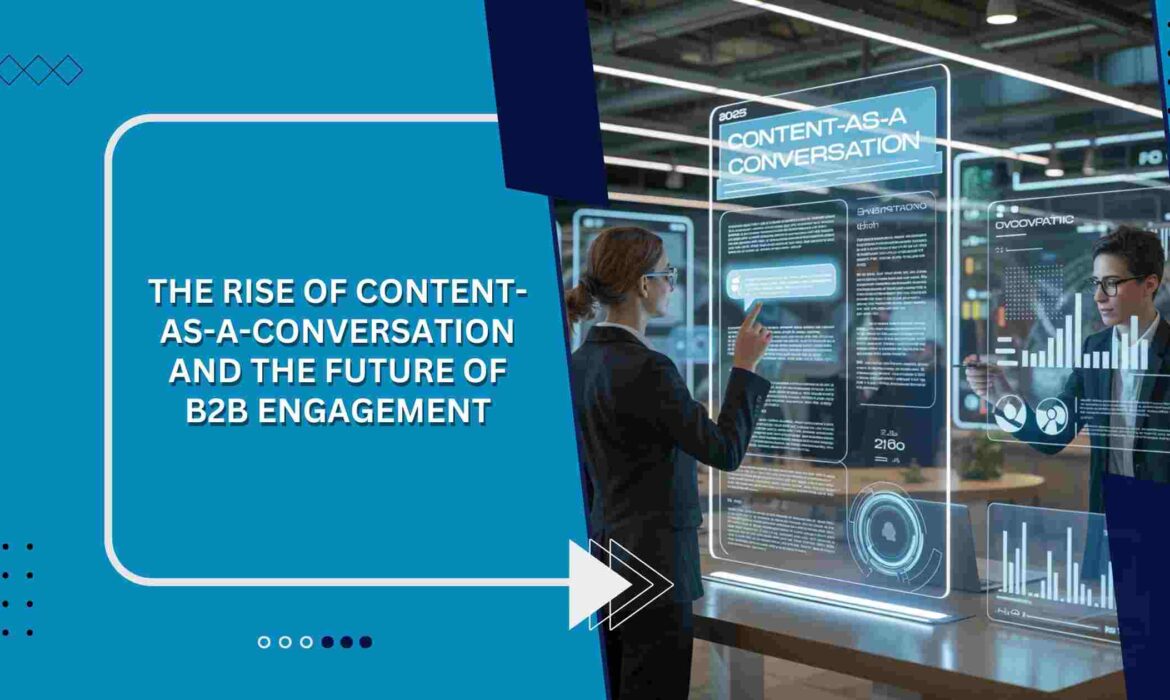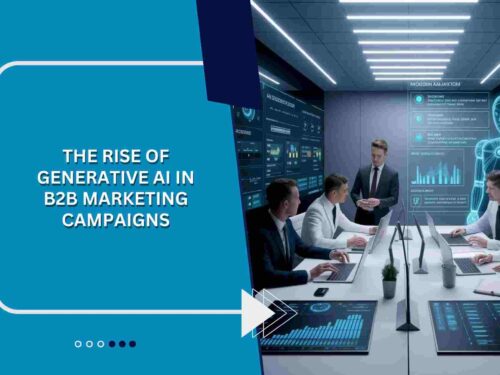B2B marketing has long revolved around whitepapers, PDFs, case studies, and static reports that deliver insights but often lack real-time engagement. Buyers downloaded them, skimmed a few pages, and left without deeper interaction. In 2025, that model is being disrupted by a more dynamic and engaging approach Content-as-a-Conversation.
This new framework is revolutionizing how businesses communicate with decision-makers. Instead of one-way communication, brands are now adopting conversational and interactive content formats that mimic real dialogues. By leveraging Content-as-a-Conversation, companies aren’t just pushing information they’re creating adaptive experiences that engage, respond, and build stronger buyer relationships.
What is Content-as-a-Conversation?
At its core, Content-as-a-Conversation is about interactivity and adaptability. Unlike static PDFs or lengthy blogs, conversational content allows the audience to guide their path, participate in real time, and even “ask” the content questions.
Picture this: a buyer downloads a 15‑page whitepaper in the old world, browses a few pages, and likely never returns. In the new model, that same content is served in an AI-embedded module where the buyer can:
- Type a question into a chatbot interface layered over the document and receive contextual answers.
- Choose from multiple content pathways (“Are you here for strategy insights or ROI data?”).
- Watch embedded video explainers as needed.
- Participate in live polls that tailor the narrative.
- Walk away with a personalized summary tailored to their role, industry, and level of technical fluency.
This not only transforms the static PDF into a living, two-way exchange but also mirrors the conversational dynamics people are experiencing daily with AI and consumer apps
Why Content-as-a-Conversation is Emerging in 2025
The rise of Content-as-a-Conversation is not accidental. Several market and technology factors are converging to make 2025 the tipping point:
1. The Rise of AI in Marketing Workflows
AI is now mainstream in B2B marketing. Natural language processing, conversational search, and real-time personalization allow businesses to create content that feels responsive and intuitive.
2. Decline of Static PDFs and Gated Content
Buyers are fatigued by filling out endless forms just to access another whitepaper. Interactive content delivers instant value and significantly reduces bounce rates.
3. Consumer Behavior Influencing B2B
Modern professionals expect the same ease of use they experience with consumer platforms like Alexa, Siri, and ChatGPT. Content-as-a-Conversation meets this demand by providing quick, tailored answers.
4. The Need for Precise Revenue Attribution
Marketers must connect content engagement to sales outcomes. Conversational content tracks behavior at a granular level revealing intent signals that PDFs could never capture.
Why Content-as-a-Conversation Matters for B2B Marketers
Higher Engagement Levels
Traditional formats often fail to hold attention. Conversational content doubles time spent per session by encouraging interaction whether through polls, pathways, or embedded tools.
Deeper Buyer Insights
Instead of tracking mere downloads, Content-as-a-Conversation captures behavioral intelligence. Marketers can analyze which topics resonate most, which questions buyers ask, and which paths lead to conversions.
Stronger Buyer Connections
Conversations build trust. Buyers feel recognized when content responds to their queries. This emotional resonance strengthens brand positioning before sales teams even step in.
Improved Pipeline Performance
With richer data and more engaged buyers, sales teams can prioritize accounts more effectively. Interactive experiences lower form abandonment rates and accelerate pipeline progression.
Real-World Applications of Content-as-a-Conversation
Interactive Whitepapers
Static reports are being replaced with AI-powered experiences. Buyers can ask, “How does this apply to financial services?” and receive tailored answers in real time.
Adaptive Landing Pages
Landing pages are evolving into conversational hubs. A CFO might see ROI-focused insights, while a CIO sees architecture and integration benefits delivering hyper-relevant experiences.
Dynamic Case Studies with Calculators
Instead of reading about a client success story, buyers can input their company’s data into embedded tools to see personalized savings and outcomes.
Post-Webinar AI Hubs
Instead of sending static recordings, brands now share interactive summaries where attendees can explore specific topics, ask questions, and receive contextual responses.
These examples demonstrate that Content-as-a-Conversation doesn’t just inform it interacts, adapts, and evolves with the user.
Strategic Shifts for Marketers
The adoption of Content-as-a-Conversation requires B2B teams to rethink their approach:
- From Content Production to Orchestration: Instead of pumping out large volumes of static content, marketers must focus on designing dynamic, adaptive experiences.
- Blending Skills Across Functions: Teams will need UX designers, AI specialists, and conversational architects to create interactive journeys.
- Personalization at Scale: AI makes it possible to deliver unique experiences to thousands of buyers simultaneously, each tailored to their role, industry, and needs.
The winners in 2025 will be those who master this orchestration and create experiences that feel alive.
Challenges Ahead
As promising as Content-as-a-Conversation is, marketers must overcome key challenges:
- Technology Integration: Embedding conversational layers requires seamless alignment between AI tools, CRM systems, and analytics platforms.
- Data Privacy and Compliance: More interaction means more data collection. Businesses must maintain transparency and adhere to evolving data regulations.
- Content Quality: Interactive formats won’t compensate for weak messaging. The foundation must still be credible and insightful.
- Scalability: Manual design of every flow isn’t sustainable. Marketers will need automation balanced with editorial oversight.
Forward-thinking organizations are already experimenting, viewing these challenges as opportunities to innovate rather than barriers.
Looking ahead, Content-as-a-Conversation will blur the line between reading an asset and engaging with a digital assistant. Buyers will expect every content piece to act as a two-way exchange.
Early adopters will hold significant advantages:
- Richer Data Lakes: They’ll collect more meaningful intent data from interactive engagements.
- Stronger Brand Perception: They’ll be seen as companies that listen first and sell second.
- Sales and Marketing Synergy: Interactive insights will arm sales teams with detailed buyer intelligence.
This evolution ensures that brands no longer publish content just for visibility they host conversations at scale. Every buyer interaction becomes a learning moment, a relationship builder, and a pipeline driver.
Key Takeaways
- Content-as-a-Conversation is redefining how B2B buyers engage in 2025.
- Static assets are giving way to dynamic, adaptive, and interactive experiences.
- AI and behavioral tracking make conversational content more powerful than ever.
- Marketers must shift from producing content in bulk to orchestrating experiences.
- Early adopters will gain stronger buyer trust, richer data, and improved ROI.
If your business is ready to embrace the future of interactive marketing and unlock the potential of Content-as-a-Conversation, now is the time to act. Start designing experiences that listen, adapt, and respond to your buyers’ needs. Connect with Acceligize to explore how conversational content can transform your B2B engagement strategy.




